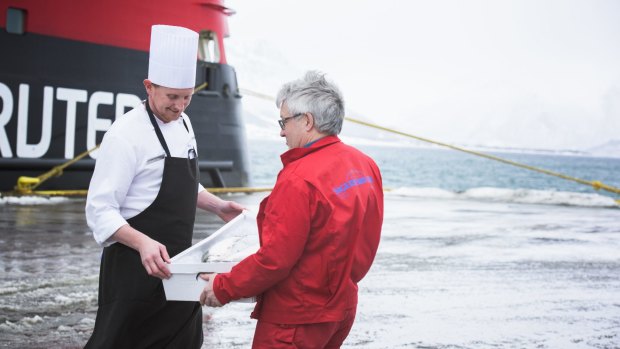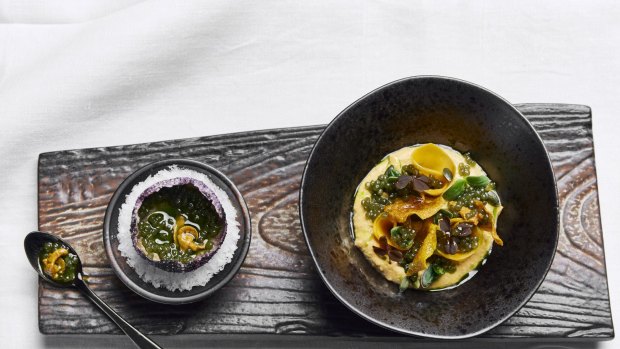This was published 1 year ago
Norway's Coastal Kitchen: Feeding Hurtigruten passengers a clean, green alternative
By Luke Slattery

Fresh, highly seasonal food is delivered directly from farms in small batches to Hurtigruten ships in Norway.
Forklifts are loading farm machinery and mail at lightning speed, alongside pallets of construction gear and crates of household goods. It's close to midnight, the sun barely dimmed, when a handful of passengers and today's shipment embark in the high Arctic city of Tromso.
Year-round at a constellation of ports stretched along the fjord-riven coastline of Norway, Hurtigruten's Coastal Express collects and delivers cargo daily – as well as local and international travellers - from Bergen in the south to Kirkenes in the north-east.
A growing consignment of cargo collected at each port is the nation's most distinctive produce – fresh, highly seasonal and often delivered directly from farms in small batches. Norway's Coastal Kitchen is the result of a decade-long campaign by Hurtigruten to source food and drinks produced and crafted along its trademark coastal route and encourage small-scale sustainable production.

Ingredients and drinks from about 60 local producers feature on daily-changing menus in Torget, the main restaurant on each of the line's eight ships, and also in Kysten, the fine-diner.
Norway has a vast coastline, about 83,000 kilometres, with rich cold-water fishing grounds and significant seasonal variation. "It was a no-brainer that we should focus on sourcing unique Norwegian foods on the routes we sail," says Oistein Nilsen, a former Hurtigruten head chef and now the line's food and beverage manager. "We travel the coast of almost the whole country. It makes no sense to import lamb from New Zealand or cheese from France, when we have the best lamb grown in Lofoten and great cheeses."
Ingredients and drinks from about 60 local producers feature on daily-changing menus in Torget, the main restaurant on each of the line's eight ships, and also in Kysten, the fine-diner, with menus featuring short stories describing provenance and food traditions. These include anecdotes about how to cure cod, traditional Nordic preserving techniques, wild-berry foraging, and how important dishes developed such as Bergen fish soup and farikal (literally, sheep in cabbage). For thousands of years the halibut, the highly prized deep-water flatfish that can weigh up to 200 kilograms, was known as the God-fish and demanded "humility and respect" from fishermen; it's lightly smoked and served for dinner with creamy cabbage and carrots two ways.
Port-to-plate produce includes the likes of Arctic char from Sigerfjord, halibut from Rogaland, smallgoods from Lonekorv, and lamb and seaweed from the scenic Lofoten archipelago. The farmer at Aalan Gard, also in Lofoten, delivers his goat's cheeses to the ship in person; one of his four cheeses is served for lunch one day with blackcurrant puree, pickled Jerusalem artichoke and hazelnuts.
Many of the ingredients are exotic and their stories make good reading over a meal. We sample dandelion syrup from the island of Rolvsoy in the far north, blueberry syrup from foraged berries at the mouth of the Reisa River, and cod roe processed in Tromso, slow-dried through winter on traditional outdoor drying racks, called hjell.
"Every day we're in a different part of Norway, and every day on the menu there's something from that area," says Nilsen. The small town of Kirkenes, for example, is the most north-easterly port on Hurtigruten's Coastal Express, close to the Finnish and Russian borders. Menus during sailings here include local reindeer, seasonally foraged cloudberries, and traditional Russian dishes such as borscht and honey cake.
Hurtigruten, which means "the fast route" in Norwegian, celebrates its 130th anniversary next year. Though bridges and sea tunnels have hastened land travel, the line remains a central part of Norwegian coastal life. The changes to its food-supply chain, too, have played an important role in supporting new and established local producers. "We have eight ships, 400 passengers on each, serving three meals a day, every day of the year," says Nilsen. "That's a serious commitment, and every year we're looking for more unique ingredients."
He says the "natural next step" for Norway's Coastal Kitchen is the recent appointment of two culinary ambassadors, young cutting-edge Norwegian chefs who will help develop menus and inspire and train the line's staff. Halvar Ellingsen runs a family farm and acclaimed restaurant at Kvitnes, in Vesteralen; and Astrid Regine Nasslander is the founder of a small abattoir and butchery called Host Matverksted, in Steigen.The summer menu at the onboard Kysten fine-diner already bears their influence – kid goat tartare, for example, uses a usually wasted resource from the dairy-goat production; and moose bone marrow in a Jerusalem artichoke soup reflects Nasslander's work with moose and elk hunters in the north and her interest in using undervalued ingredients. Sea-urchin roe features on menus, from a species that has thrived since the overfishing of catfish and cod in the 1960s and has since destroyed swathes of northern Norway's native kelp forests.
Seaweed, a long-standing Norwegian ingredient, is a common thread through current menus. "We recognise the importance of kelp forests for biodiversity and absorbing carbon, so we're keen to use local sugar kelp in our menus," says Nilsen. "But we're also looking at taking the next step of growing seaweed. We're always looking at ways to reduce carbon emissions and help the environment."
Luke Slattery travelled as a guest of Hurtigruten.
Sign up for the Traveller Deals newsletter
Get exclusive travel deals delivered straight to your inbox. Sign up now.